Tending to garden foliage and ensuring its maintenance can be a cumbersome challenge. Finding the correct tools to do the same efficiently, while sticking to a budget is an additional bother. Given how difficult times are, you may want to steer clear of reviewing such tools and buy anything that fits the bill. But would you go for a weed wacker or weed trimmer without knowing their attributes? Surely not, right?
A majority of these products serve the same purpose which is getting rid of parasitic weed plants and grass. Weed Wackers and Weed Trimmers, are two such effective tools and will give you a run for your money; now let’s find out who takes home all the glory, in this unbiased rundown of Weed Wacker VS Trimmer.
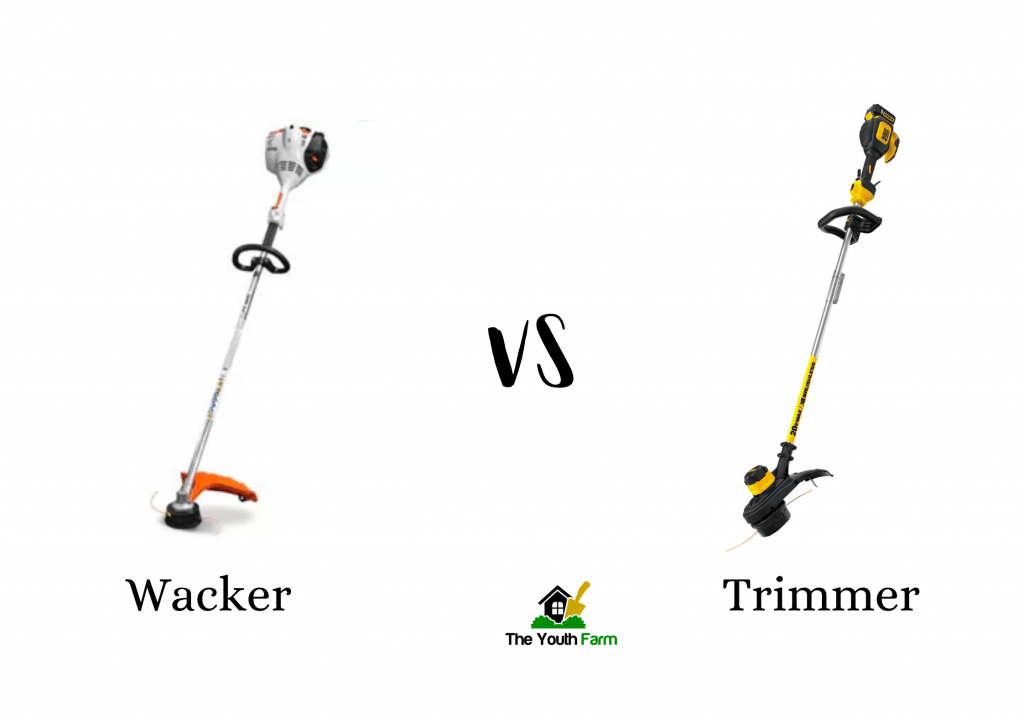
Weed wackers and weed trimmers are two different types of grass-trimming devices that are in equal demand. If similar names were not an issue already, their identical working mechanisms and appearances are even more misleading. This is why we have curated this article to ease your worries. The best way to get a clear winner between the two is to use a good old comparison.
Let’s find out which products’ qualities surpass the other by pitching them against each other.
See Also: Husqvarna Lawn Tractor Review | The Real Gardening Solution?
Weed Wacker VS Trimmer| Determining The Victor
Weed wackers are more commonly known as weed eaters or string trimmers. This concept was introduced in the 1970s by a resident of Texas, George C Ballas. Inspired by the mechanism used in automatic car-washing stations, George was fixated on creating a similar automatic cropping tool. This led to the inception of his company with the same name, Weed Eaters, which strived to help customers with weeds in their garden.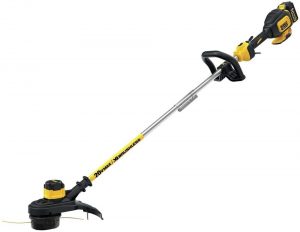
Weed whackers have come a long way since then and a majority of them have garnered positive attention. A lot of the performance does depend on whether the wacker contains faulty parts, but most experienced gardeners are pleased with it. Well-known weed wackers like the Makita XRU15 PT1 and EGO ST 1521S have been rigorously tested by various organizations and yielded satisfactory results. Others like the Husqvarna 325iLK have varied strengths like raw weed-slashing power or extended battery life. The effectiveness of the machine also depends on the type of string that is being used in the main head.
On the other hand, bladed trimmers worked primarily, based on the inventions by best-selling inventor King C.Gillette. These trimmers are much heavier and sturdier machines that require a considerable amount of monetary investment. Trimmers tend to have knife blades, chisel knives, smasher blades, or mulching blades. 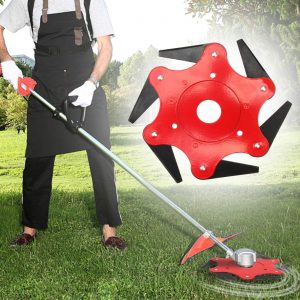
While knife blades are more inexpensive, longer-lasting, and suited to general grass trimming, chisel knives are smaller but more aggressive counterparts. Like weed wackers, trimmers also have both gas and electricity options. Gas-powered trimmers have a longer operating time while electric trimmers are eco-friendly and negate the hassle concerning fuel liquids. Weed trimmers, in general, are suited for use in urban and suburban areas due to their design structure.
Which Has a Better Design and Durability?
Weed Wackers
Weed wackers or string trimmers consist of a long shaft with the motor on one end and a gyrating head propeller of plastic or nylon line on the other. Just like weed trimmers, these are available with tow-behind or walk-behind tractor mechanisms. Note that these tractors are capable of far more work than dedicated brush cutting. Especially for the walk-behind tractors, the user can switch between weed wacker, rototiller, snow blower, firewood splitter, pressure washer, etc. Given, how you might not be using these all year round, do consider getting attachments for devices that perform other lawn-care tasks. Additionally, string trimmers are adapted for heavy use as their 20 to 30 cc motors cannot handle daily utility.
Though your operating time may vary a few hours depending on whether you’re using a handheld or corded machine, 2-3 hours is generally the limit. Cordless weed wackers will also require a battery that has been properly charged. String trimmers depend heavily on the line feed at the bottom of their heads to cut grass. In case the trimmer head takes in too much dirt, it can clog the line feed and make it come to an unwanted halt. While this might also be applicable for dense undergrowth, these wackers are more or less equipped to handle basic trimming.
Weed Trimmers
Conversely, weed trimmers are more accurate in nature. Apart from the same design structure, they have grass-cutting heads which can be fitted onto detachable string trimmer heads as well! Handheld trimmers are a little heavier to use but employ flail heads or circular saw disks to get rid of stubborn woody growths. These consume a good amount of power as their 40 cc motors are significantly more potent than weed wacker motors.
Walk-behind tractors for this tool generally work best for tall, coarse, thick grass, weeds, and weedy shrubs. Tow-behind models are more of industry-grade equipment as they have larger mowing blades and require a towing vehicle. Some of these models have their own engine while others link to the vehicle’s power take-off (PTO) via a shaft which then helps propel the blade.
There are alternatives to the fuel-based model as well. Rarer 4-cycle prototypes may fatigue users but are eventually more sustainable and environment-friendly. 2-cycle machines are more frequent, but pollute more and require more preparation time for the oil-gasoline mixture to be prepped.
Measuring the Positives and Negatives (With Comparison Chart)
Weed Wacker Pros
- Safer for use
- Lithium-ion batteries extend the life
- Appropriate for trimming and leveling grass
- Portable design
- Wide choice of strings for different types of foliage
- Longer running time
- Ease of handling
- Minimal noise
- Decreased vibration from motor and trimmer head means easier control
- Variety of shaft handles for user’s convenience
- Affordable
- Easy maintenance
- Bump-and-feed and fixed string models offer more alternatives
Weed Wacker Cons
- Centrifugal force-based application can cause trimmer head to get clogged more often
- Bump-and-feed mechanism may require a more frequent replacement of the nylon line.
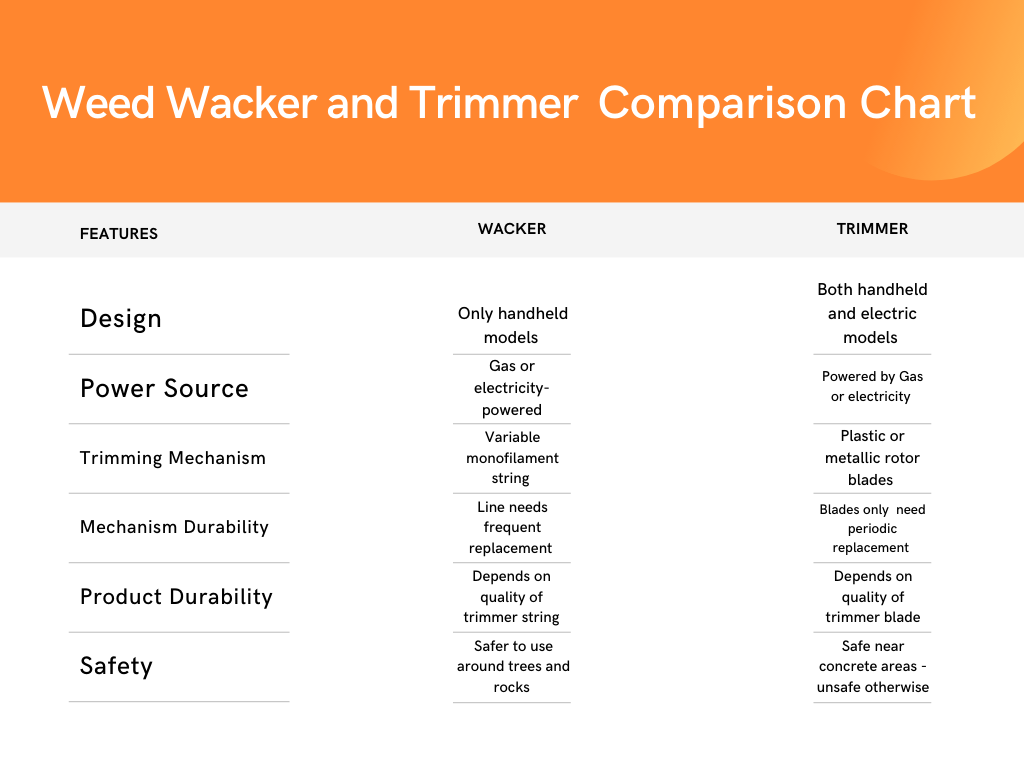
Weed Trimmer Pros
- Heavy duty
- Alternatives for daily use and sporadic useNeutralizes free radicals
- Makes light work of dense undergrowth and stubborn foliage
- Greater cutting width of blades ranging from 9 inches to 15 feet
- Inbuilt heavy gauge steel housing, pneumatic tires, and powerful engines for tow-behind and walk-behind models
- Blades can be installed easily
- The nature of blades and their usage makes them last longer than strings
- Industrial grade and used at a more professional level
- The vertical nature of blades helps in perimeter control
Weed Trimmer Cons
- All weed trimmers are costlier than string trimmers or weed wackers
- Not safe for use near trees and rocks due to the risk of flying debris and malfunction
Weed Wacker vs Weed Trimmer Comparison Chart
Weed Wacker VS Trimmer | Customer Reviews
About Weed Wackers, Sam says, “I bought this to replace the same model Weedeater I have had and used for the last 15+ years. It simply works all the time. I gassed it up with a 50:1 fuel oil mixture, followed instructions for priming and starting and I was weaving through the grass in minutes. A full choke often cuts off the engine. However, I moved it to the center position when first starting and it started right away. My experience with the old model helped, no doubt. A simple adjustment is all it needed. I expect to get many years of use out of this trimmer. The double line spool can be a bother. Although it is a powerful double-line trimmer, I prefer to just load one-half of the spool and use it as a single-line trimmer. The double line is great for weeds, but I just have grass around my house. At my height, the straight shaft means no bending over to cut. Love it!”
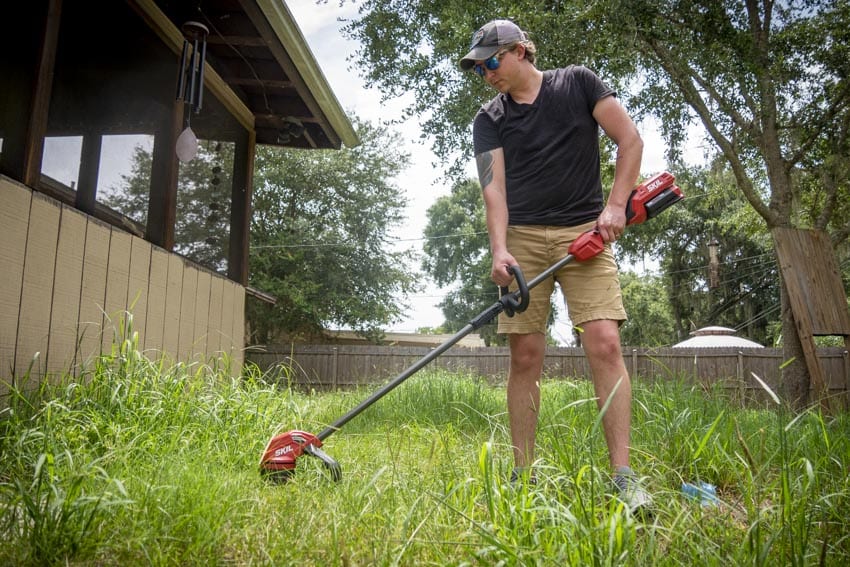
About Weed Wackers, Miguel says, “Just got my new model yesterday. I’ve had one for 6 years prior which I made good use of. I generally mow several yards in my neighborhood on the weekends and this is by far the best trimmer I ever used. It is light yet powerful and starts effortlessly. The other feature I like about it is there’s no clutch so it will spin while idling if you want to do some trimming at low speed. Runs real smooth and quiet. I highly recommend this item for the weekend warrior!”
About Weed Trimmers, Rick says, “This does in minutes what the line takes 10-15 to complete. I was concerned that my 26cc Homelite was going to have issues powering this blade, but it does not. It takes a second for it to come up to speed, and whirrs like a fan when it does, but mowing down tall thick grasses was a breeze. Unlike with the line, it never got set back. The blade can be a bit intimidating at times. You’d have no issues hitting your shoe with the line. But the blade head will likely send you to the emergency ward if you’re not alert. Use the guard, stay vigilant and make sure to wear goggles as rocks fly when you hit them. I would recommend a 5/16″ fender washer for the adapter bushing for best results!”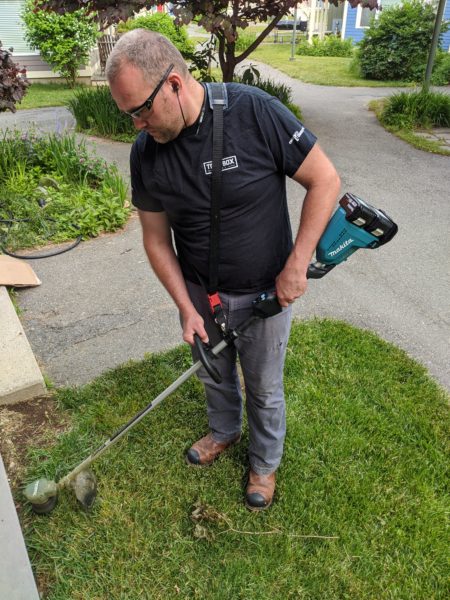
About Weed Trimmers, Naijel says, “I have tons of weeds on my ten-acre property that hasn’t been cleared in years. I have gotten rid of thousands of saplings with this and the blade is still in good shape. This stuff works best for trees less than an inch in diameter but will work for bigger ones as well. It works pretty well on grass also. ”
FAQs | Weed Wacker VS Trimmer
What Is a Good Weed Wacker or Weed Trimmer Replacement?
Weed wackers and weed trimmers are by themselves very target-specific equipment. If you’re looking for blade or string replacements you can look those up here. However, if you’re unsatisfied with both of these products, you will most likely need a lawnmower or professional assistance with better equipment.
How Do I Go About the Weed Wacker and Weed Trimmer Attachment?
Weed wackers will have single-line trimmers, double-line trimmers, or speed-feed trimmers. For each of these, the application is different but the main steps include prepping the line, detaching the cap, and locating the starting hole. The attachment is quite similar to how you would reel the wire to and from a cord extender appliance.
For weed trimmers, you must remove the trimmer head by placing the locking pin in the small head on the back of the gear head first. Then unscrew the trimmer head by turning it clockwise. Place the grass blade on top of the drive disc and follow it up with the support cup and support flange. Fasten the locking nut and reattach the locking pin onto the gearhead.
Where Can I Get a Weed Wacker Trimmer Combo?
Since the main heads are different, weed wackers and weed trimmers are not usually sold together. However, you can get weed wacker and leaf blower combos almost everywhere. Sites like Home Depot have several combinations of such gardening equipment that you can avail.
Where can I buy Weed Wacker and Weed Trimmer Blades?
Several online retailers sell weed wackers and weed trimmer blades. Though they are not sold together, they are not mutually exclusive products. Usually, sites like Amazon will have both weed wackers and weed trimmer blades in stock.
Also read: Snake Holes in Yard | Tackling Them In 2022 (Guide)
Closure | Weed Wacker VS Trimmer
As with every comparison and analysis article, it is now time to conclude and give you our verdict. Though both products serve very similar purposes, none of them can be called a winner in any regard. This is because their usability varies as a result of their design. Bladed trimmers possess vertical shanks which are best for edging out haphazard growths. String trimmers or weed wackers are more suited to leveling grass or getting rid of smaller patches of weeds.
Depending on your budget, you would also need to determine whether a handheld trimmer works for you or a walk-behind is what you need. Tow-behind models are generally for use on farms so that would almost entirely be out of the question. However, it is recommended that you take stock of your current equipment and then combine and use it with either of these. As moderately pricey tools, you would ideally need to buy only one model and use it sustainably. With this, we reach the end of the debate regarding weed wackers and trimmers!
